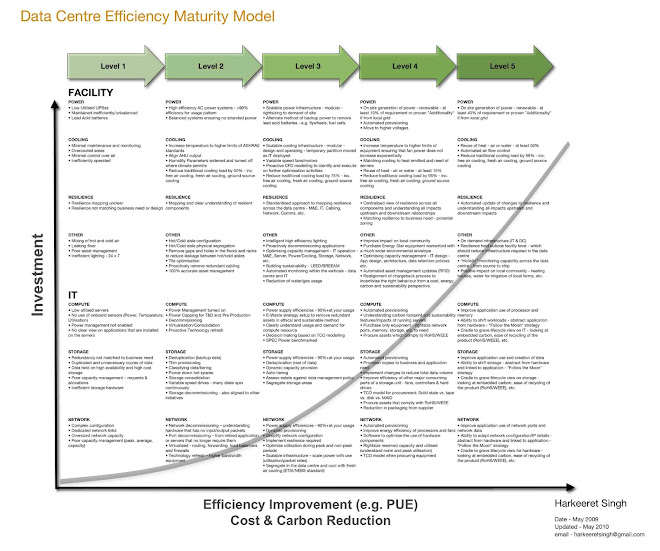I have extended the IT part of the model, which has now been split into Compute, Storage and Network. Each area outlines a number of initiatives for an organisation to undertake in order to improve the efficiency and sustainability of their IT operation.
Saturday, 8 May 2010
Expanding the IT section
To date there has been very positive feedback on the Data Centre Efficiency Maturity Model. I have further expanded the model to include all major energy consuming parts of a data centre. IT energy consumption in a typical data centre tends to be 60% Servers, 25 - 30% Storage and 10-15% Network.
I have extended the IT part of the model, which has now been split into Compute, Storage and Network. Each area outlines a number of initiatives for an organisation to undertake in order to improve the efficiency and sustainability of their IT operation.
I have extended the IT part of the model, which has now been split into Compute, Storage and Network. Each area outlines a number of initiatives for an organisation to undertake in order to improve the efficiency and sustainability of their IT operation.
Labels:
Compute,
Energy Consumption,
IT,
Maturity Model,
Network,
Storage,
Sustainibility
Thursday, 8 April 2010
History
The Data Centre Maturity Model was created over the last year brought about to fill a gap in the industry and provide direction to help organisations drive efficiency and sustainability improvements.
The X and Y axis directionally show business benefit and impact - efficiency improvement and cost.
Level 1 is a view on where many data centres are today and Level 5 on the Maturity Model is an aspirational target and provides guidance on the cutting edge initiatives within the industry to improve your organisation's environmental impact.
The X and Y axis directionally show business benefit and impact - efficiency improvement and cost.
Level 1 is a view on where many data centres are today and Level 5 on the Maturity Model is an aspirational target and provides guidance on the cutting edge initiatives within the industry to improve your organisation's environmental impact.
Subscribe to:
Comments (Atom)
